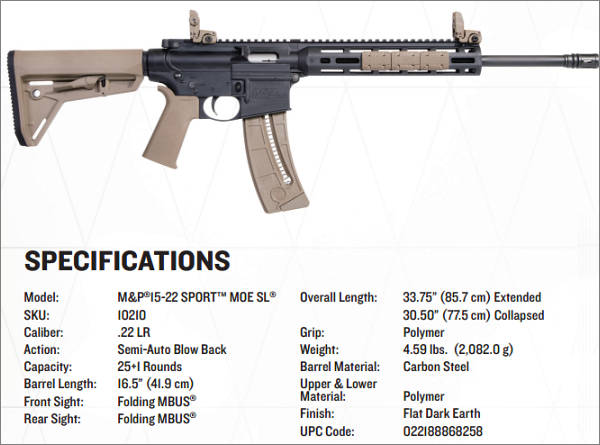Sunday Gunday: .22 LR AR-Style Rifles for Cross-Training and Fun

AR-Style .22 LR Rimfire Rifles
For affordable, low-recoil shooting fun it’s hard to beat a semi-auto .22 LR. While Ruger’s 10/22 is the most popular semi-auto .22 LR rifle, many manufacturers are now offering AR-style self-loading rimfire rifles. We like AR-style .22 LR rigs for Rimfire Tactical Matches and 3-Gun cross-training. With an AR-style rimfire rifle you can train with low-cost ammunition while enjoying the same ergonomics, controls, and sighting systems found on your centerfire ARs.
If you shoot service rifle, and want to train at a fraction of the cost of shooting centerfire, a rimfire AR clone makes sense. This allows you to practice with a rifle with the same feel, balance, and ergonomics of your .223 Rem/5.56×45 service rifle.
These rimfire versions of the AR-15 are excellent training tools for 3-Gun and tactical match shooters. You can practice with less expensive rimfire ammo, and save wear and tear on your centerfire ARs. Rimfire AR clones also work great for Rimfire Tactical Matches.
Below we feature a variety of popular .22 LR rimfire AR-style rifles, including the Smith & Wesson M&P 15-22, the Tippman Arms series of rimfire ARs, and the HK 416 marketed by Walther.
Smith & Wesson M&P 15-22

Smith & Wesson has upgraded its M&P 15-22, a fun rifle that we’ve praised in the past. The latest M&P 15-22 Sport MOE SL model (Magpul Original Equipment Slim Line) features a more comfortable handguard, an improved grip, and an adjustable Magpul buttstock. The dedicated .22 LR M&P rifle retains the look and features of the company’s popular M&P rifle line, with the enhanced ergonomics of Magpul furniture. It’s offered with Flat Dark Earth (tan) furniture or dressed in matte black.
Field Testing the Smith & Wesson M&P 15-22
Smith & Wesson’s 15-22 is a nice little rifle. The M&P 15-22 is designed and built as a true .22 LR semi-auto from the ground up, with ergonomics (and most controls) identical to a centerfire M&P 15 rifle. NRA reviewer Colon Noir tested the M&P 15-22 and was impressed: “This gun is unbelievably fun to shoot. There is virtually no recoil. The non-existent recoil makes shooting fast a breeze. Yeah, the magazine is a little quirky… but in the grand scheme of things, this gun feels like a full-out AR-15. The M&P 15-22 makes for a great training companion. I would place this gun in the ‘Fun Box’ — it’s reliable enough that you can have a fun time shooting. I’m picking one up, because it’s guns like these that make you truly realize how fun shooting is.”
Here’s a Video Review of the M&P 15-22 by the NRA’s Colin Noir
Tippmann Arms .22 LR AR-Type Rifles
Tippmann Arms makes a large variety of AR-15 style rimfire rifles. Tippmann also offers “house-brand” .22 LR magazines that work great with virtually all .22 LR ammunition — even the low-cost bulk ammo. To learn more, watch the videos below, which demonstrate the excellent functionality and reliability of the Tippmann AR clones. We also recommend the Shooting Sports USA Review of the Tippman Arms M4.
Owners have been very impressed with these Tippmann .22 LR semi-auto rifles. They are very reliable and have ergonomics/layout identical to a centerfire AR15. That makes them ideal for cross-training. Here are comments from some Tippman .22 LR rifle owners:
“Wanted a dedicated .22 LR to shoot with my 22 suppressor. I have a CMMG .22 LR conversion for use in my ARs. I just didn’t like ‘dirtying’ up my regular ARs shooting rimfire. So I bought the Tippmann. Very impressed with the gun. Runs well, and great quality. And I hear they have great customer service. And unlike some other “22LR” ARs, the Tippman is identical to a regular AR as far as controls, feel, and operation. Great for training, or plinking!”
“The wife and I have been running a Tippmann Redline in matches for a year now. Great rifle and company. Picked-up one of the speedloaders last fall and it makes a huge difference in both speed and comfort. No more sore thumb syndrome from loading those 25-round mags.”
Walther HK 416 D145RS .22 LR Rifle
Walther Arms offers an excellent, high-quality .22 LR AR-15 clone sold with the Heckler Koch (HK) label. The HK 416 D is a good cross trainer with high-quality construction and good reliability. The HK 416 D145RS Semi-Automatic Rifle in .22 L.R. is manufactured exclusively by Walther under license from HK. It is the only genuine HK tactical rimfire replica available.















 In our
In our  Neck-Wall Thickness is Important Too
Neck-Wall Thickness is Important Too






